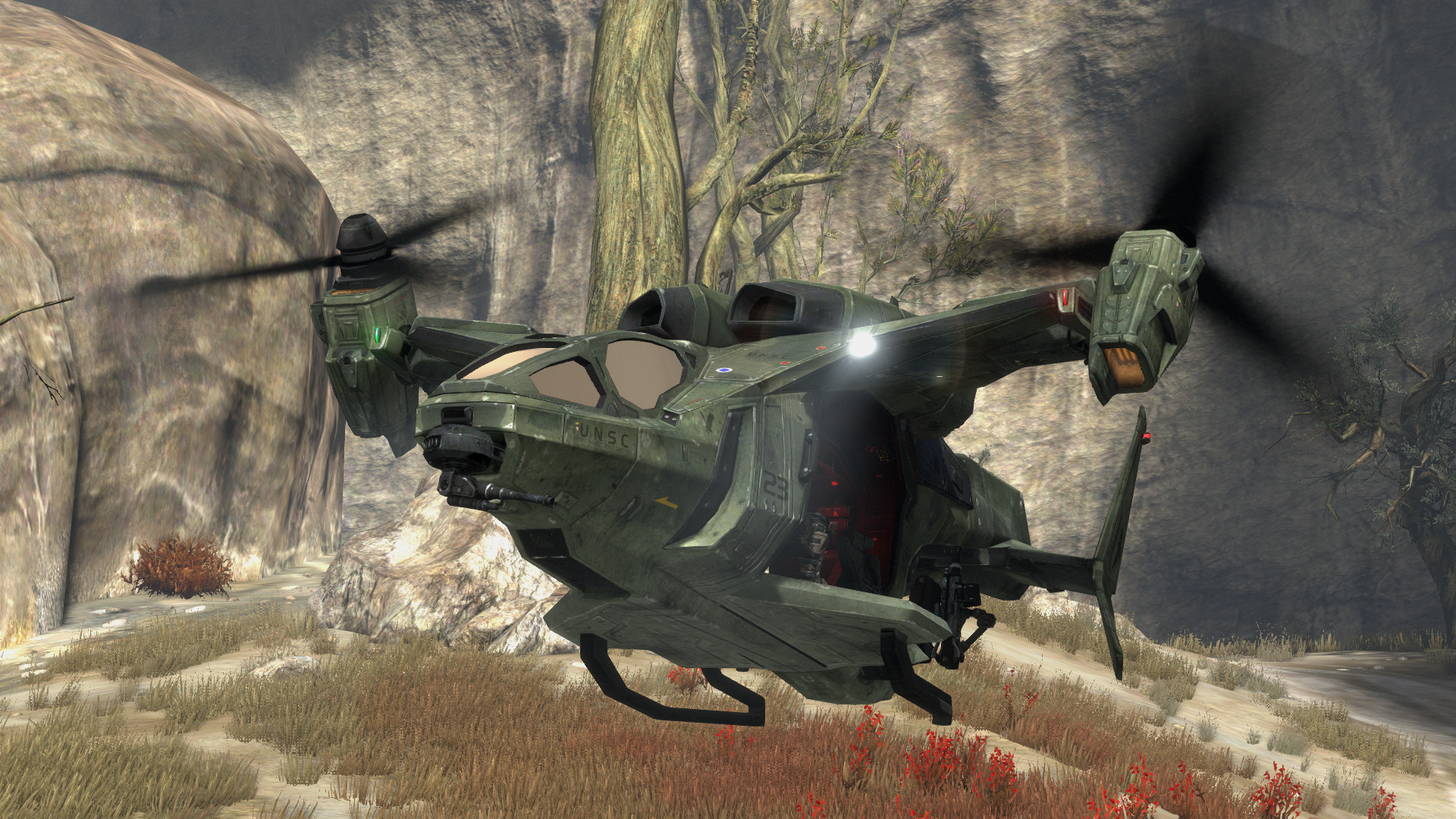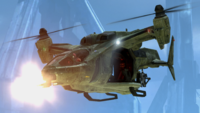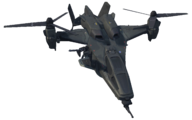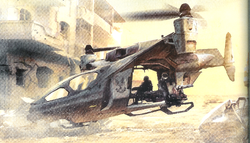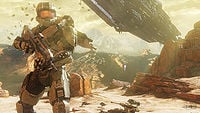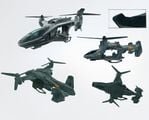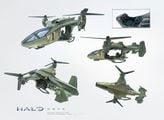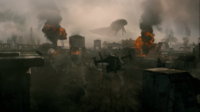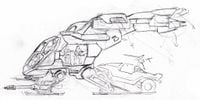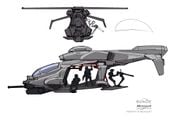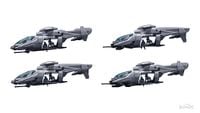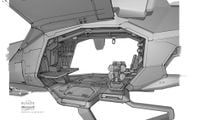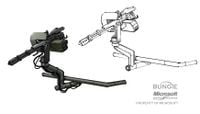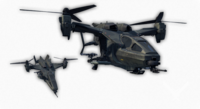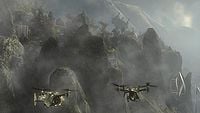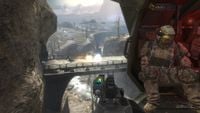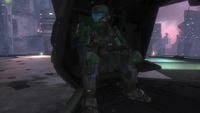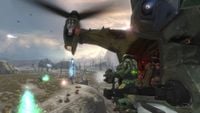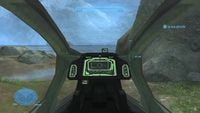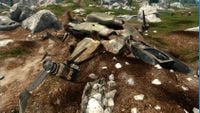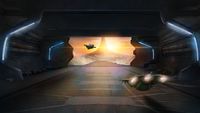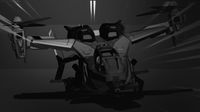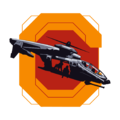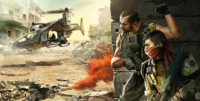UH-144 Falcon
From Halopedia, the Halo wiki
| UH-144 Falcon | |
|---|---|
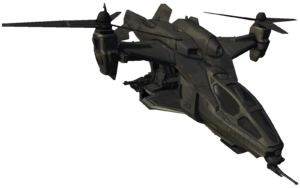
| |
| Production information | |
|
Manufacturer: |
|
|
Model: |
UH-144[2] |
| Technical specifications | |
|
Length: |
|
|
Width: |
|
|
Height: |
|
|
Mass: |
|
|
Maximum speed: |
296 kilometers per hour (184 mph)[2] |
|
Engine(s): |
Twin turboprop engines[2] |
|
Armament: |
|
|
Crew: |
|
|
Complement: |
|
| Usage | |
|
Year introduced: |
|
|
In service: |
|
|
Role(s): |
|
|
Affiliation: |
|
The Utility Helicopter-144, or UH-144 Falcon, is a versatile, multipurpose utility helicopter built by Misriah Armory and used by the UNSC Army.[1][2][3] Manufactured by Misriah Armory,[1] the Falcon is used for troop transport and deployment, as well as air-to-ground support.[7] The primary utility helicopter within the United Nations Space Command's sizable fleet of vertical take-off and landing aircraft, the Falcon is one of the most popular transports within the Army, famed for its effective arsenal and speed.[5]
Overview[edit]
Design details[edit]
The UH-144 Falcon is a versatile, multipurpose utility helicopter.[2] Unlike the nimble AV-14 Hornet or the swift AV-22 Sparrowhawk, the Falcon is exceptionally discreet, while remaining incredibly effective.[5] The Falcon gained favor within the UNSC Army for proving to be an economical alternative to the larger Pelican dropships for short-range troop transportation and deployment.[2] A pair of Falcons can easily and quickly transport a fully-equipped infantry squad faster than any previous helicopter, while providing overwhelming support fire, in most weather conditions.[5][9] The Falcon's hull is sturdy, able to easily shrug off small arms fire and even certain heavier attacks.[10]
The frame of the Falcon is composed of a single elongated fuselage with a narrow, single-man cockpit and a large rear cabin, flanked by small wings.[2] The pilot resides in the closed cockpit, while the crew have their choice of two gunner seats in extended buckets, two interior passenger seats, an aft bench, and a limited amount of standing room.[1][5] Gunners secured themselves within the Falcon with a safety harness that hung from the ceiling.[11]
Propulsion[edit]
The Falcon is a vertical take-off and landing aircraft, equipped with a transverse rotor and engine pod on each wing. Although the rotors are powerful and capable of lifting a fully-loaded Falcon on their own, two dorsal-routed jet turbines provide most of the helicopter's thrust during forward flight.[2] To take off, the Falcon's rotors are angled so that the rotor blades are vertical. When the Falcon has reached the desired height, the pilot tilts the rotors forward so that the rotor blades are near horizontal. In this mode, the wings provide some of the lift, and the rotors provide thrust as a propeller.[12] It is still not however a true tilt-rotor aircraft, as the rotors do not tilt into a fully horizontal position, relying primarily on the jet turbines for forward flight.
The twin-turbine system gives the Falcon an extremely agile range of maneuverability.[13] The Falcon's impressive maneuverability makes the helicopter an ideal aircraft for the tight confines of many battlefield environments, ranging from a narrow gorge, a dense forest, to even a skyscraper-laden cityscape.[1][5] The Falcon is capable of reaching a maximum speed of 296 kilometers per hour (184 miles per hour).[2]
Armaments[edit]
Distinguished by its unquestionably effective and relatively heavy weaponry,[1][5] the Falcon is capable of being fitted with a wide variety of armaments. The primary armament of the Falcon is an M638 20mm autocannon, fixed in a nose turret below the pilot's main cabin. The autocannon provides effective suppressive fire when extracting or deploying personnel.[2] Flanking the vehicle on both sides are modular weapon emplacements that vary depending on the Falcon variant.[5] The emplacements are installed on flexible mount hardpoints on either side of the open cabin, selected at the discretion of the Falcon's crew.[2] The UH-144A variant is armed with a pair of M460 automatic grenade launchers, while the UH-144S variant sports standard M247H 12.7mm heavy machine guns. Both have proven incredibly effective against Covenant aircraft and providing point-to-point suppressive and attack fire on enemy ground emplacements and infantry.[5]
Variants[edit]
- UH-144A Falcon: The "attack" variant of the Falcon, armed with two side-mounted M460 automatic grenade launchers as secondary armament.[1]
- UH-144S Falcon: The "support" variant of the Falcon, armed with two side-mounted M247H Heavy Machine Guns as secondary armament.[1]
Operational history[edit]
The Falcon was introduced into service with the United Nations Space Command in 2497, though the helicopter only proved truly common with garrison forces of the UNSC Army on Inner Colony worlds.[2] The Falcon was used during the Insurrection.[6]
Falcons were used throughout the Human-Covenant War, including during the Battle of Fumirole in April 2552.[14] Falcons were used extensively during the Fall of Reach throughout the summer of 2552. Notably, the Falcons Kilo 33 and 34 transported NOBLE Team to SWORD Base in an effort to end the Covenant assault on the facility.[15] Numerous Falcons later participated in the Battle at Szurdok Ridge.[16] Falcons would later participate in evacuation efforts and troop movement operations during the Siege of New Alexandria. One would carry SPARTAN-B312 to Caracalla Park to disable an Ceudar-pattern heavy corvette pinning down escaping civilian transport ships.[17] Later during the siege, B312 piloted a Falcon to aid UNSC forces across the city and take down Covenant jammers.[8] Several Falcons later saw action during the Battle of Installation 04, having survived the UNSC Pillar of Autumn's initial arrival on the ring in September 2552. These craft aided Fireteam Raven in various ground actions against the Covenant occupational forces, transporting Raven from the Battle of Alpha Base to the ringworld's Control Room,[18] and later providing air support during their suicidal last stand to defend Pillar of Autumn's crash site.Template:Ref/Lvel Falcons were also used during the Battle for Earth with one such craft that crashed into a hotel in the New Mombasa Section 21 during the Battle of Mombasa.[19][20]
During their operation on Gao in 2553, the 717th Xeno-Materials Exploitation Battalion was equipped with two UH-144S Falcons, used for patrol as well as troop and supply transportation. When the Keepers of the One Freedom attacked the battalion, one of the Falcons was destroyed instantly and crashed into the Montero Vitality Center, while the second shrugged off the attack and fled towards the village of Wendosa.[21] Over the course of the battalion's battle with the Keepers, the remaining Falcon provided troop transport and supply drops for the UNSC forces.[22] However, the Falcon was eventually crashed in the Montero Jungle when the pilot was killed mid-flight days later.[11] As of 2557, the Falcon remains in active service with the UNSC Army.[23]
Gameplay[edit]
- Main article: Falcon
The Falcon is the primary playable UNSC air in Halo: Reach. It replaced the role held by the Hornet in Halo 3, though has not been featured in any Halo games since. In-game, it fulfills the role of "Warthog of the sky", as nicknamed by Brian Jarrard.[24] It can transport several players or NPCs throughout the battlefield and provide light support.
Production notes[edit]
The Falcon's origins extend back into the early production of Halo 2. Early prototypes for the vehicle were experimented with by Marcus Lehto, though they were ultimately cut from the game. In this early Halo 2 era, the Falcon was a single-pilot craft capable of transporting four players, though some concept sketches played with having a troop bay similar in nature to the one eventually released in Halo: Reach. Lehto continued to play with the Falcon concept going into Halo 3's development, producing a design that would ultimately go on to become that game's Hornet.[25] However, when Lehto went on to direct Reach, he still wanted to release a vehicle closer to his original vision. Concept artist Isaac Hannaford was responsible for designing the Falcon in Reach, and played with several concept variations during development. Early explorations took the idea established in Halo 2 with a more conventional UNSC aerodyne and a rear troop bay, though later on added in the helicoptor rotors that ultimately define the final look.
Early renders of the Falcon from earlier stages of Reach's development saw the aircraft labelled with decals reading "VMX-22". In the real-world, VMX-22 was an organisation responsible for testing the MV-22B Osprey tiltrotor aircraft. The final game's model lacks these decals, though still retains some other unit markings such as Air Mobility Express.
Halo 4[edit]
Early promotional screenshots of Halo 4 depicted Falcons flying around on the level Reclaimer. These assets reuse the background "flock" Falcons present in Reach that fly around in the skybox at an extremely low-detail scale. They were removed from the final game. However, concept art for a visually-updated Falcon was produced by Digital Extremes artist Dejan Ostojic during the production of the game's downloadable content. The artwork was intended for the Majestic DLC map Skyline, with Ostojic producing both Falcon and Hornet concept designs. The Falcon ultimately did not make the final cut, with the Hornet instead being featured on the map.[26]
Trivia[edit]

|
See our gameplay information related to UH-144 Falcon on its gameplay page. |

|
Browse more images in this article's gallery page. |
- A falcon is a bird of prey, in keeping with the UNSC's tradition of naming atmospheric vehicles after real animals with the exceptions of the GA-TL1 Longsword, B-65 Shortsword, F-41 Broadsword, and FSS-1000 Sabre, which are named after bladed weapons.
- Superficially, the Falcon looks rather similar to the United States Marine Corps' V-22 Osprey tilt rotor. However, the Osprey's rotor blades tilt directly forward in flight.
- A Falcon avatar gear is one of the bonus items included with the Halo: Reach Limited and Legendary editions.
Gallery[edit]
A Falcon passing over Kat during the Battle of Fumirole in Deliver Hope.
Early concept art for the Falcon for Halo: Reach suggests that it was originally a conventional helicopter, as opposed to the tiltrotor design found in the final game.
Two Falcons on Reach.
A downed Falcon in Halo: Fireteam Raven.
Concept art of a UH-144 Falcon in a hangar for the Pelican Training experience of Halo: Outpost Discovery.
A Halo Infinite multiplayer emblem of the Falcon.
Insurrectionists preparing to attack a UNSC UH-144 Falcon in the Halo Encyclopedia (2022 edition).
List of appearances[edit]
- Halo: The Fall of Reach
- Adjunct (Mentioned only)
- Remember Reach
- Birth of a Spartan (Director's cut) (First appearance)
- Deliver Hope
- Halo: Reach
- Halo: Last Light
- Halo: Ground Command
- Halo Mythos
- Halo: Fireteam Raven
- Halo: Official Spartan Field Manual
- Halo: Outpost Discovery
- Halo Infinite (Emblem only)
Sources[edit]
- ^ Jump up to: a b c d e f g h i j k l m n o p q Halo: The Essential Visual Guide, page 67
- ^ Jump up to: a b c d e f g h i j k l m n o p q r s t u v Halo Waypoint, Falcon (Retrieved on Oct 29, 2015) [archive]
- ^ Jump up to: a b c d e f g h i j k l m Halo Encyclopedia (2022 edition), page 154
- ^ Halo: Reach Official Strategy Guide, page 343
- ^ Jump up to: a b c d e f g h i j k Halo Waypoint, Falcon (Retrieved on Mar 14, 2011) [local archive] [external archive]
- ^ Jump up to: a b c Halo Mythos, page 56
- ^ Jump up to: a b Halo: Reach manual
- ^ Jump up to: a b Halo: Reach, campaign level New Alexandria
- ^ Bungie.net, UH-144 Falcon (Retrieved on Oct 12, 2014) [archive]
- ^ Halo: Last Light, p. 238
- ^ Jump up to: a b Halo: Last Light, p. 260
- ^ Halo: Reach
- ^ Halo Encyclopedia (2011 edition), page 260
- ^ Halo: Reach marketing, Remember Reach campaign, Deliver Hope
- ^ Halo: Reach, campaign level ONI: Sword Base
- ^ Halo: Reach, campaign level Tip of the Spear
- ^ Halo: Reach, campaign level Exodus
- ^ Halo: Fireteam Raven, campaign level Raven Down
- ^ Halo: Reach, multiplayer map Breakneck
- ^ Halo Waypoint, Halo: Anniversary Map Pack (Retrieved on Oct 12, 2014) [archive]
- ^ Halo: Last Light, p. 162-168
- ^ Halo: Last Light, p. 235
- ^ Halo Waypoint, Canon Fodder - Feet First (Retrieved on Feb 11, 2019) [archive]
- ^ Bungie.net, Bungie Weekly Update: 01.29.10 (Retrieved on Oct 14, 2014) [archive]
- ^ Twitter, Marcus Lehto (@game_fabricator): "Yes! I was playing around with 3D concepts of it right after HaloCE" (Retrieved on Jul 1, 2019) [archive]
- ^ ArtStation, Halo 4 - vehicles (Retrieved on Apr 13, 2025) [archive]
| ||

